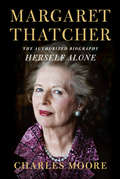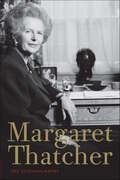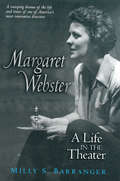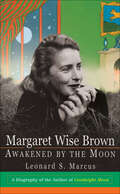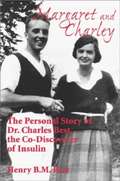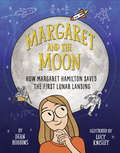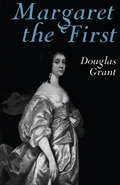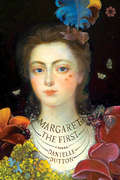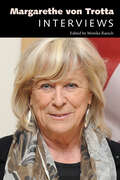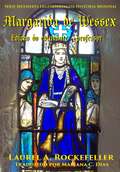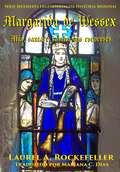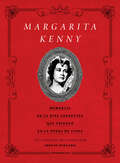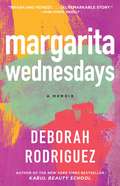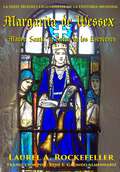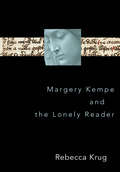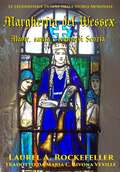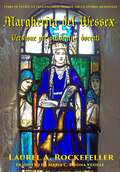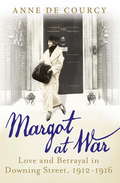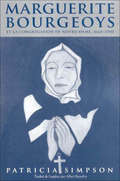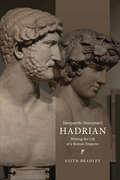- Table View
- List View
Margaret Thatcher: The Authorized Biography: Herself Alone
by Charles MooreCharles Moore's masterful and definitive biography of Britain's first female prime minister reaches its climax with the story of her zenith and her fall.How did Margaret Thatcher change and divide Britain? How did her model of combative female leadership help shape the way we live now? How did the woman who won the Cold War and three general elections in succession find herself pushed out by her own MPs?Charles Moore's full account, based on unique access to Margaret Thatcher herself, her papers, and her closest associates, tells the story of her last period in office, her combative retirement, and the controversy that surrounded her even in death. It includes the fall of the Berlin Wall, which she had fought for, and the rise of the modern EU that she feared. It lays bare her growing quarrels with colleagues and reveals the truth about her political assassination.Moore's three-part biography of Britain's most important peacetime prime minister paints an intimate political and personal portrait of the victories and defeats, the iron will but surprising vulnerability of the woman who dominated in an age of male power. This is the full, enthralling story.
Margaret Thatcher: The Autobiography
by Margaret ThatcherPublished in a single volume for the first time, Margaret Thatcher is the story of her remarkable life told in her own words--the definitive account of an extraordinary woman and consummate politician, bringing together her bestselling memoirs The Downing Street Years and The Path to Power. Margaret Thatcher is the towering political figure of late-twentieth-century Great Britain. No other prime minister in modern times sought to change the British nation and its place in the world as radically as she did.Writing candidly about her upbringing and early years and the formation of her character and values, she details the experiences that propelled her to the very top in a man's world. She offers a riveting firsthand history of the major events, the crises and triumphs, during her eleven years as prime minister, including the Falklands War, the Brighton hotel bombing, the Westland affair, the final years of the Cold War, and her unprecedented three election victories. Thatcher's judgments of the men and women she encountered during her time in power-from statesmen, premiers, and presidents to Cabinet colleagues-are astonishingly frank, and she recalls her dramatic final days in office with a gripping, hour-by-hour description from inside 10 Downing Street. Powerful, candid, and compelling, Margaret Thatcher stands as a testament to a great leader's significant legacy.
Margaret Webster: A Life in the Theater
by Milly S. BarrangerMargaret Webster: A Life in the Theater is an engrossing backstage account of the life of pioneering director Margaret Webster (1905-72). This is the first book-length biography of Webster, a groundbreaking stage and opera director whose career challenged not only stage tradition but also mainstream attitudes toward professional women. Often credited with first having brought Shakespeare to Broadway, and renowned for her bold casting of an African American (Paul Robeson) in the role of Othello, Webster was a creative force in modern American and British theater. Her story reveals the independent-minded artist undeterred by stage tradition and unmindful of rules about a woman's place in the professional theater. In addition to providing fascinating glimpses into Webster's personal and family life, Margaret Webster: A Life in the Theater also offers a who's-who list of the biggest names in New York and London theater of the time, as well as Hollywood: John Gielgud, Noël Coward, George Bernard Shaw, Uta Hagen, Sybil Thorndike, Eva LeGallienne, and John Barrymore, among others, all of whom crossed paths with Webster. Capping Webster's amazing story is her investigation by Senator Joseph McCarthy and HUAC, which left her unable to work for a year, and from which she never fully recovered.
Margaret Wise Brown: Awakened By The Moon
by Leonard S. Marcus"Leonard S. Marcus... has masterfully written about a fascinating woman who in her short life changed literature for the very young. I was throroughly enchanted."--Eric CarleNearly fifty years after her sudden death at the age of forty-two, Margaret Wise Brown remains a legend and an enigma. Author of Goodnight Moon, The Runaway Bunny, and dozens of other children's classics, Brown all but invented the picture book as we know it today. Combining poetic instinct with a profound empathy for small children, she understood a child's need for security, love, and a sense of being at home in the world. Yet, these were comforts that had eluded her. Her sparkling presence and her unparalleled success as a legendary children's book author masked an insecurity that left her restless and vulnerable.In this authoritative and moving biography, Leonard S. Marcus, who had access to never-before-published letters and family papers, portrays Brown's complex character and her tragic, seesaw life. Colorful, thoughtful, and insightful, Margaret Wise Brown is both a portrayal of a woman whose stories still speak to millions and a portrait of New York in the 1930s and 1940s, when the literary world blossomed and made history.
Margaret and Charley: The Personal Story of Dr. Charles Best, the Co-Discoverer of Insulin
by Henry B.M. BestAlthough Charles Best is known for discovering insulin, the story of his life neither begins nor ends with that one moment. Not only did he make many other discoveries, he was also one half of an extraordinary couple who, during their almost sixty years together, were involved in many of the significant events of the twentieth century. Margaret & Charley is the story of these two people from their beginnings on the east coast at the turn of the century through the years that followed. Through diaries, scrapbooks, photograph albums, and other documentation, the details of their lives are shared with the reader.
Margaret and the Moon
by Dean RobbinsA true story from one of the Women of NASA!Margaret Hamilton loved numbers as a young girl. She knew how many miles it was to the moon (and how many back). She loved studying algebra and geometry and calculus and using math to solve problems in the outside world. Soon math led her to MIT and then to helping NASA put a man on the moon! She handwrote code that would allow the spacecraft&’s computer to solve any problems it might encounter. Apollo 8. Apollo 9. Apollo 10. Apollo 11. Without her code, none of those missions could have been completed. Dean Robbins and Lucy Knisley deliver a lovely portrayal of a pioneer in her field who never stopped reaching for the stars.
Margaret the First: A Biography of Margaret Cavendish, Duchess of Newcastle, 1623-1673
by Douglas GrantMargaret Cavendish was one of the most original, loveable and eccentric of women writers. Pepys called her "mad, ridiculous, and conceited" but when she paid her famous visit to London in 1667 he ran all over town to see her. And many of her other contemporaries were no less fascinated. Posterity has continued to feel the attraction; to her many admirers she has always been "the incomparable Princess," and Lamb enthusiastically praised her as "the thrice noble, chase, and virtuous—but again somewhat fantastical, and original-brain'd, generous Margaret Newcastle." This biography is the first full-length study entirely devoted to the Duchess of Newcastle. It shows Margaret's metamorphosis from an imaginative, bashful child into a romantic public figure, and how, after living at home among a family unusual in its loyalties, she served as lady-in-waiting to Queen Henrietta Maria during the Civil War and in exile married William Cavendish, the "Loyal" Duke of Newcastle, before emerging as the first woman writer of her times—"Margaret the First" as she wished to be known. Her poetry, fiction, drama and natural philosophy, along with her many other writings, are treated as facets of her extraordinary personality delightful in itself and also valuable as an illustration of the spirit of the age. The illustrations are unusually good and include a fine unpublished portrait of the Duchess, a photo of her effigy in Westminster Abbey and reproductions of several of the ornate engraved title-pages of her works.
Margaret the First: A Novel
by Danielle DuttonOne of both Flavorwire and The Millions Most Anticipated Books of 2016Margaret the First dramatizes the life of Margaret Cavendish, the shy, gifted, and wildly unconventional 17th-century Duchess. The eccentric Margaret wrote and published volumes of poems, philosophy, feminist plays, and utopian science fiction at a time when "being a writer" was not an option open to women. As one of the Queen's attendants and the daughter of prominent Royalists, she was exiled to France when King Charles I was overthrown. As the English Civil War raged on, Margaret met and married William Cavendish, who encouraged her writing and her desire for a career. After the War, her work earned her both fame and infamy in England: at the dawn of daily newspapers, she was "Mad Madge," an original tabloid celebrity. Yet Margaret was also the first woman to be invited to the Royal Society of London-a mainstay of the Scientific Revolution-and the last for another two hundred years.Margaret the First is very much a contemporary novel set in the past. Written with lucid precision and sharp cuts through time, it is a gorgeous and wholly new narrative approach to imagining the life of a historical woman.
Margaret's Machine (Fountas & Pinnell Classroom, Guided Reading)
by Catherine Friend Ron MazellanNIMAC-sourced textbook. Inventing the Paper Bag. Paper bags are boring, right? Not if you know the story behind their invention.
Margaret's Story (Florida Trilogy #3)
by Eugenia PriceSynopsis Margaret Seton Fleming's life spanned the years 1813-1878. Although the family suffers many tragedies, Margaret has the ability to hope most of the time. She remains very strong throughout the story.
Margarethe von Trotta: Interviews (Conversations with Filmmakers Series)
by Monika RaeschMargarethe von Trotta (b. 1942) entered the film industry in the only way she could in the 1960s—as an actress. Throughout her career, von Trotta added thirty-two acting credits to her name; however, these credits came to a halt in 1975. Her ambition had always been to be a movie director. Though she viewed acting as a detour, it allowed her to be in the right place at the right time, and through her line of work she met such important directors as Rainer Werner Fassbinder and Volker Schlöndorff. The latter would eventually provide her with the opportunity to codirect her first film, Die Verlohrene Ehre der Katharina Blum (The Lost Honor of Katharina Blum) in 1975. The debut's success ensured von Trotta's future in the film industry and launched her accomplished film directing career. In Margarethe von Trotta: Interviews, volume editor Monika Raesch furnishes twenty illuminating interviews with the auteur. Spanning three decades, from the mid-1980s until today, the interviews reveal not only von Trotta's life in the film industry, but also evolving roles of and opportunities provided to women over that time period. This collection of interviews presents the different dimensions of von Trotta through the lenses of film critics, scholars, and journalists. The volume offers essential reading for anyone seeking a better understanding of an iconic female movie director at a time when this possibility for women just emerged.
Margarida de Wessex: Edição do estudante-professor (Mulheres Legendárias da História — Livros de Estudo #10)
by Laurel A. RockefellerA história inspiradora de Margarida de Wessex, rainha consorte de Malcolm III Canmore de Alba, ganha vida nessa edição especial do estudante-professor —planejada para ser usada em escolas e em casa. Perguntas que induzem a compreensão da leitura, lógica e pensamento crítico se unem ao aprendizado de história para criar uma adição robusta, mas acessível, ou um ponto de referência, para aulas de estudos sociais. Apêndices no fim do livro fornecem informações que são referências-chaves, incluindo uma linha do tempo detalhada cobrindo 3.000 anos de história da Escócia. Unidades de tempo medievais são tanto explicadas nos apêndices quando aplicadas na narrativa. Um material essencial para todos os cursos de estudos sociais. Para idades 12+.
Margarida de Wessex: Mãe, santa e Rainha dos escoceses (Série Mulheres Legendárias da História Mundial #10)
by Laurel A. RockefellerO século 11 foi uma época perigosa para os descendentes diretos do Rei Æthelred II Despreparado e de sua primeira rainha, Æfgifu of York. Nascida na Hungria depois da tentativa falha do Rei Canuto III de assassinar o seu pai, Eduardo, o Exilado, Margarida teve a vida virada de cabeça para baixo pela descoberta do Rei Eduardo, o Confessor, de que o seu pai continuava vivo — e com a consequente reconvocação de sua família à Inglaterra. Agora, uma refém política mantida viva apenas enquanto serve aos interesses de homens poderosos, Margarida e sua família encontram no convite do Rei Máel Coluim mac Donnchadh Ceann à sua corte em Dunfermline, Alba, a resposta há muito esperada para as suas preces. A Escócia jamais seria a mesma outra vez.
Margarita Kenny: Memorias de la diva argentina que triunfó en la Ópera de Viena
by Sergio PángaroAnécdotas y reflexiones fascinantes de una cantante wagneriana argentina de sangre irlandesa y alma germana que fue amada y aplaudida en Europa. Un aporte a la historia cultural de la segunda mitad del siglo XX y una celebración del arte como salvación. Margarita Kenny (Venado Tuerto, Argentina, 1915-2008) fue una cantante de ópera que debutó en el Teatro Colón de Buenos Aires en 1943. Al tiempo que se producía el ascenso del coronel Perón al poder, partió a Filadelfia a perfeccionarse y de allí saltó a una Europa de posguerra que, conforme ella demostraba su talento, le abrió paso a los escenarios más prestigiosos de la lírica internacional, especialmente, el de la Ópera de Viena, que la aplaudió por veinte años. Mezzosoprano en los inicios de su carrera, soprano dramática en su consagración, el repertorio wagneriano fue su marca: decía de sí que su sangre era irlandesa, su corazón argentino y su alma germana. Mimada de la nobleza europea en general y de la familia Wittgenstein (era íntima de Paul) en particular, antes de dejar la Argentina había trabajado como periodista en El Hogar y columnista en radio El Mundo. En sus últimos años confió al músico y escritor Sergio Pángaro sus memorias, en la forma de largas charlas grabadas en casetes, pletóricas de referencias que fue necesario fijar recurriendo a diversas fuentes de época. El resultado de ese trabajo monumental y amoroso es este libro único, que rescata a un personaje fascinante prácticamente desconocido por el gran público, y singular por la multiplicidad de temas que aborda, que, más allá de lo estrictamente relacionado con la escena musical, lo convierten en un aporte a la historia cultural de la segunda mitad del siglo XX y una celebración del arte como salvación.
Margarita Wednesdays
by Deborah RodriguezIn answer to the question of what happened following her New York Times bestseller Kabul Beauty School, Deborah Rodriquez is back with a new memoir.Irreverent, insightful, and blatantly honest, Deborah takes us along on her inspiring journey of self-discovery and renewal after she is forced to flee Afghanistan in 2007. She first lands in California, where she feels like a misfit teetering on the brink of sanity. Where was that fearless redhead who stared danger in the face back in Kabul? After being advised to commune with glowworms and sit in contemplation for one year, Rodriguez finally packs her life and her cat into her Mini Cooper and moves to a seaside town in Mexico. Despite having no plan, no friends, and no Spanish, a determined Rodriguez soon finds herself swept up in a world where the music never stops and a new life can begin. Her adventures and misadventures among the expats and locals help lead the way to new love, new family, and a new sense of herself. In the magic of Mexico, she finds the hairdresser within, and builds the life she never knew was possible--a life on her own terms.
Margarita de Wessex: Madre, Santa, y Reina de los Escoceses (Mujeres Legendarias de la Historia del Mundo #10)
by Laurel A. RockefellerEl siglo XI fue una época peligrosa para pertenecer a la línea ininterrumpida del rey Æthelred II el Indeciso y su primera reina, Æfgifu de York. Nacida en Hungría tras el intento fallido del rey Canuto III de asesinar a su padre, Eduardo el Exiliado, Margarita vio cómo su vida daba un vuelco cuando el rey Eduardo el Confesor descubrió que su padre había sobrevivido, y la consiguiente devolución de su familia a Inglaterra. Convertida en un rehén político que sólo se mantenía vivo mientras sirviera a los intereses de los hombres poderosos, Margarita y su familia encontraron en la invitación del rey Máel Coluim mac Donnchadh Ceann Mhor a su corte en Dunfermline, en Alba, la respuesta largamente esperada a sus plegarias. Escocia nunca volvería a ser la misma.
Margery Kempe and the Lonely Reader
by Rebecca KrugSince its rediscovery in 1934, the fifteenth-century Book of Margery Kempe has become a canonical text for students of medieval Christian mysticism and spirituality. Its author was a fifteenth-century English laywoman who, after the birth of her first child, experienced vivid religious visions and vowed to lead a deeply religious life while remaining part of the secular world. After twenty years, Kempe began to compose with the help of scribes a book of consolation, a type of devotional writing found in late medieval religious culture that taught readers how to find spiritual comfort and how to feel about one's spiritual life. In Margery Kempe and the Lonely Reader, Rebecca Krug shows how and why Kempe wrote her Book, arguing that in her engagement with written culture she discovered a desire to experience spiritual comfort and to interact with fellow believers who also sought to live lives of intense emotional engagement.An unlikely candidate for authorship in the late medieval period given her gender and lack of formal education, Kempe wrote her Book as a revisionary act. Krug shows how the Book reinterprets concepts from late medieval devotional writing (comfort, despair, shame, fear, and loneliness) in its search to create a spiritual community that reaches out to and includes Kempe, her friends, family, advisers, and potential readers. Krug offers a fresh analysis of the Book as a written work and draws attention to the importance of reading, revision, and collaboration for understanding both Kempe’s particular decision to write and the social conditions of late medieval women’s authorship.
Margherita del Wessex: Madre, santa e regina di Scozia (Le leggendarie donne della storia mondiale #10)
by Laurel A. RockefellerIl secolo XI non era il momento migliore per un discendente diretto di re Etelredo lo Sconsigliato e della sua prima moglie Æfgifu di York. Nata in Ungheria, a seguito del fallito tentato omicidio di suo padre, Edoardo l’Esiliato, ordinato da re Canuto III, Margherita verrà inaspettatamente catapultata in Inghilterra, quando il suo prozio, re Edoardo il Confessore, apprenderà che Edoardo l’Esiliato è riuscito a sfuggire al tentato omicidio ordinato dal suo predecessore. Dopo alcuni anni, le sorti di Margherita e la sua famiglia vedranno un altro inaspettato colpo di scena, da ostaggi politici sotto i normanni, grazie ad una rocambolesca fuga, si ritroveranno ospiti di re King Máel Coluim mac Donnchadh Ceann Mhor a Dunfermline, capitale del regno di Alba. Con l’arrivo di Margherita, la Scozia non sarà mai più la stessa.
Margherita del Wessex: Versione per studenti e docenti (Le leggendarie donne della storia mondiale #10)
by Laurel A. RockefellerLa storia entusiasmante di Margherita del Wessex, moglie di Malcolm III Canmore, re del regno di Alba, prende vita in questa edizione per studenti e docenti appositamente creata per l’uso in aula e a casa. Le domande si prefiggono lo scopo di favorire la comprensione del testo ed il pensiero logico durante l’apprendimento della storia. In coda al testo vengono fornite appendici relative alla computazione del tempo in epoca medievale ed una dettagliatissima cronologia della storia scozzese che comprende eventi accaduti nell’arco di circa 3000 anni. Questo libro è uno strumento indispensabile nell’ampliamento della conoscenza storica. Adatto ad un pubblico dai 12 anni in poi.
Margot at War: Love and Betrayal in Downing Street, 1912-1916
by Anne de CourcyMargot Asquith was perhaps the most daring and unconventional Prime Minister's wife in British history. Known for her wit, style and habit of speaking her mind, she transformed 10 Downing Street into a glittering social and intellectual salon. Yet her last four years at Number 10 were a period of intense emotional and political turmoil in her private and public life. In 1912, when Anne de Courcy's book opens, rumblings of discontent and cries for social reform were encroaching on all sides - from suffragettes, striking workers and Irish nationalists. Against this background of a government beset with troubles, the Prime Minister fell desperately in love with his daughter's best friend, Venetia Stanley; to complicate matters, so did his Private Secretary. Margot's relationship with her husband was already bedevilled by her stepdaughter's jealous, almost incestuous adoration of her father. The outbreak of the First World War only heightened these swirling tensions within Downing Street. Drawing on unpublished material from personal papers and diaries, Anne de Courcy vividly recreates this extraordinary time when the Prime Minister's residence was run like an English country house, with socialising taking precedence over politics, love letters written in the cabinet room and gossip and state secrets exchanged over the bridge table. By 1916, when Asquith was forced out of office, everything had changed. For the country as a whole, for those in power, for a whole stratum of society, but especially for the Asquiths and their circle, it was the end of an era. Life inside Downing Street would never be the same again.
Margot at War: Love and Betrayal in Downing Street, 1912-1916
by Anne de CourcyMargot Asquith was perhaps the most daring and unconventional Prime Minister's wife in British history. Known for her wit, style and habit of speaking her mind, she transformed 10 Downing Street into a glittering social and intellectual salon. Yet her last four years at Number 10 were a period of intense emotional and political turmoil in her private and public life. In 1912, when Anne de Courcy's book opens, rumblings of discontent and cries for social reform were encroaching on all sides - from suffragettes, striking workers and Irish nationalists. Against this background of a government beset with troubles, the Prime Minister fell desperately in love with his daughter's best friend, Venetia Stanley; to complicate matters, so did his Private Secretary. Margot's relationship with her husband was already bedevilled by her stepdaughter's jealous, almost incestuous adoration of her father. The outbreak of the First World War only heightened these swirling tensions within Downing Street. Drawing on unpublished material from personal papers and diaries, Anne de Courcy vividly recreates this extraordinary time when the Prime Minister's residence was run like an English country house, with socialising taking precedence over politics, love letters written in the cabinet room and gossip and state secrets exchanged over the bridge table. By 1916, when Asquith was forced out of office, everything had changed. For the country as a whole, for those in power, for a whole stratum of society, but especially for the Asquiths and their circle, it was the end of an era. Life inside Downing Street would never be the same again.
Margot at War: Love and Betrayal in Downing Street, 1912-1916
by Anne de CourcyMargot Asquith was perhaps the most daring and unconventional Prime Minister's wife in British history. Known for her wit, style and habit of speaking her mind, she transformed 10 Downing Street into a glittering social and intellectual salon. Yet her last five years at Number 10 were a period of intense emotional and political turmoil in her private and public life. In 1912, when Anne de Courcy's book opens, rumblings of discontent and cries for social reform were encroaching on all sides - from suffragettes, striking workers and Irish nationalists. Against this background of a government beset with troubles, the Prime Minister fell desperately in love with his daughter's best friend, Venetia Stanley; to complicate matters, so did his Private Secretary. Margot's relationship with her husband was already bedevilled by her stepdaughter's jealous, almost incestuous adoration of her father. The outbreak of the First World War only heightened these swirling tensions within Downing Street. Drawing on unpublished material from personal papers and diaries, Anne de Courcy vividly recreates this extraordinary time when the Prime Minister's residence was run like an English country house, with socialising taking precedence over politics, love letters written in the cabinet room and gossip and state secrets exchanged over the bridge table. By 1916, when Asquith was forced out of office, everything had changed. For the country as a whole, for those in power, for a whole stratum of society, but especially for the Asquiths and their circle, it was the end of an era. Life inside Downing Street would never be the same again.Read by Patricia Gallimore(p) 2015 Isis Publishing Ltd
Marguerite Bourgeoys et la Congrégation de Notre Dame, 1665-1670
by Patricia SimpsonMarguerite Bourgeoys (1620-1700) was canonized in 1982. Patricia Simpson goes beyond myth and hagiography to explore Bourgeoys's dream of establishing a radically new religious community of women, recounting her thirty-year struggle to obtain official recognition for the Congrégation of Notre-Dame. Simpson shows that the order faced great resistance from the male Church hierarchy despite the fact that the pioneer society depended on the work of the Congrégation. The order was particularly important in assuming the guardianship of many filles du roi - young women sent to New France under royal auspices to be married to the men of the colony. Simpson also examines the many difficulties the Congrégation faced, which included natural disasters and the dangers involved in trying to reach women and children in settlements throughout New France, as far away as Acadia.
Marguerite Yourcenar’s Hadrian: Writing the Life of a Roman Emperor (Phoenix Supplementary Volumes #62)
by Keith BradleyMarguerite Yourcenar is best known as the author of the 1951 novel Mémoires d’Hadrien, her recreation of the life of the Roman emperor Hadrian. The work can be examined from the perspective of the issues raised by writing Roman imperial biography at large and the many ways in which Mémoires has a claim to historical authenticity. In Marguerite Yourcenar’s Hadrian, Keith Bradley explains how Mémoires d’Hadrien came to be written, gives details of Yourcenar’s own biography, and describes some of the intricate historical problems that her novel’s portrait of Hadrian presents. He draws on Yourcenar’s correspondence, her interviews with journalists, and her literary corpus as a whole, emphasizing Yourcenar’s profound knowledge of the ancient evidence on which her life of Hadrian is based and exploiting a wide range of contemporary Yourcenarian criticism. The book pays special attention to the methods by which Yourcenar believed Hadrian’s life history to be recoverable, compares examples of modern life-writing, and contrasts the procedures of conventional Roman biographers. Revealing how and why Mémoires d’Hadrien is as it is, Marguerite Yourcenar’s Hadrian illustrates how imaginative literary recreation is often little different from historical speculation.
